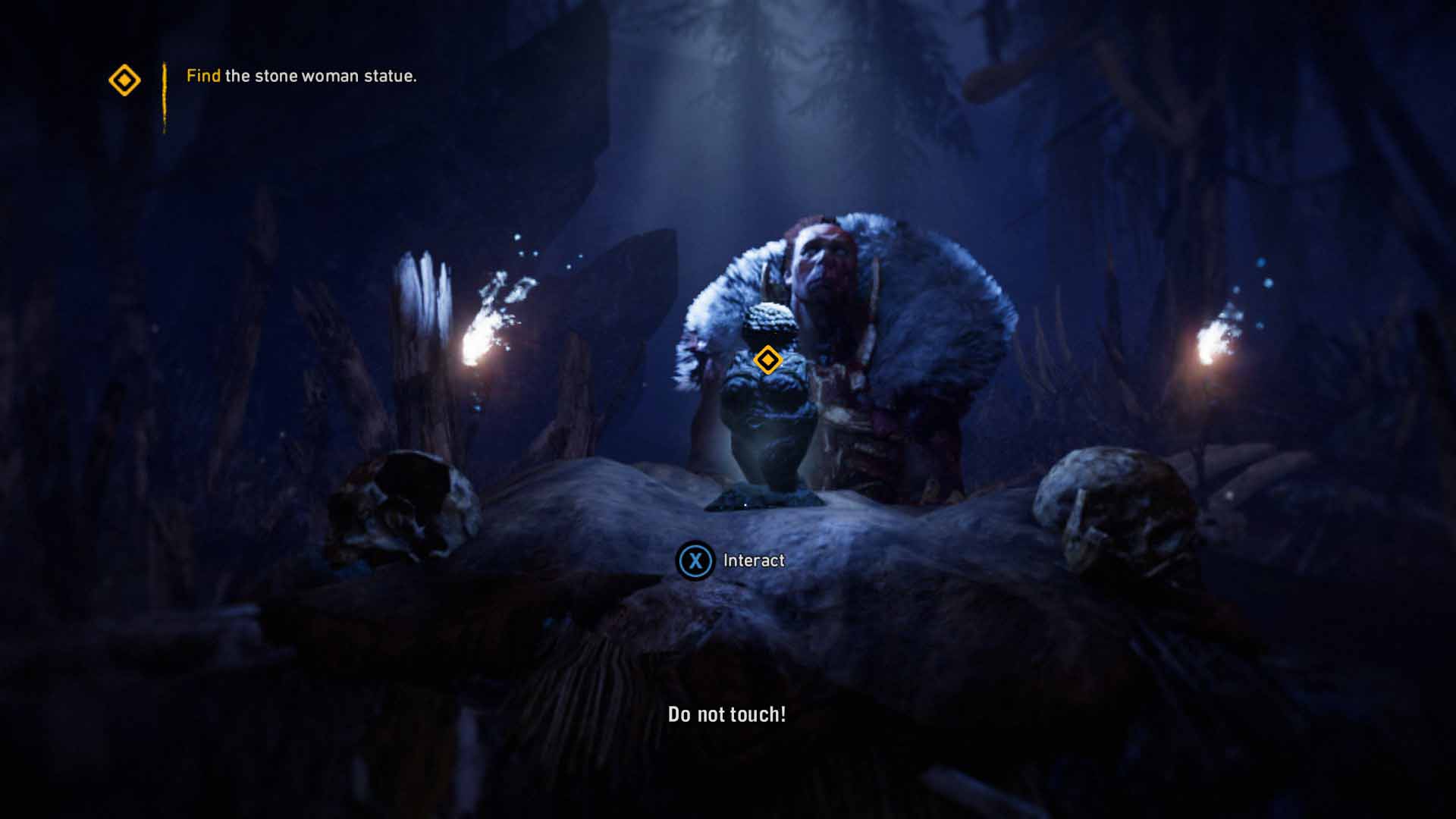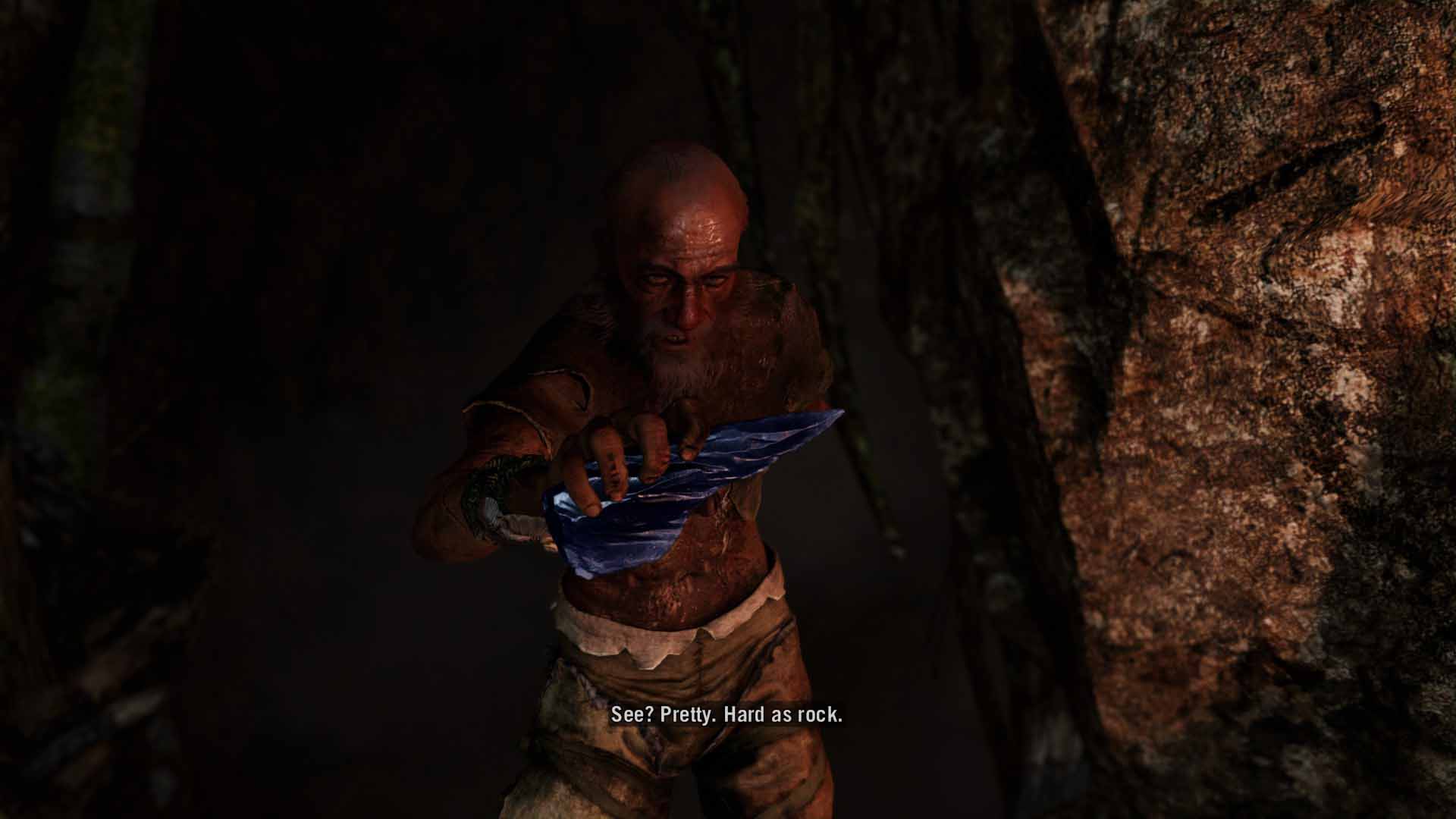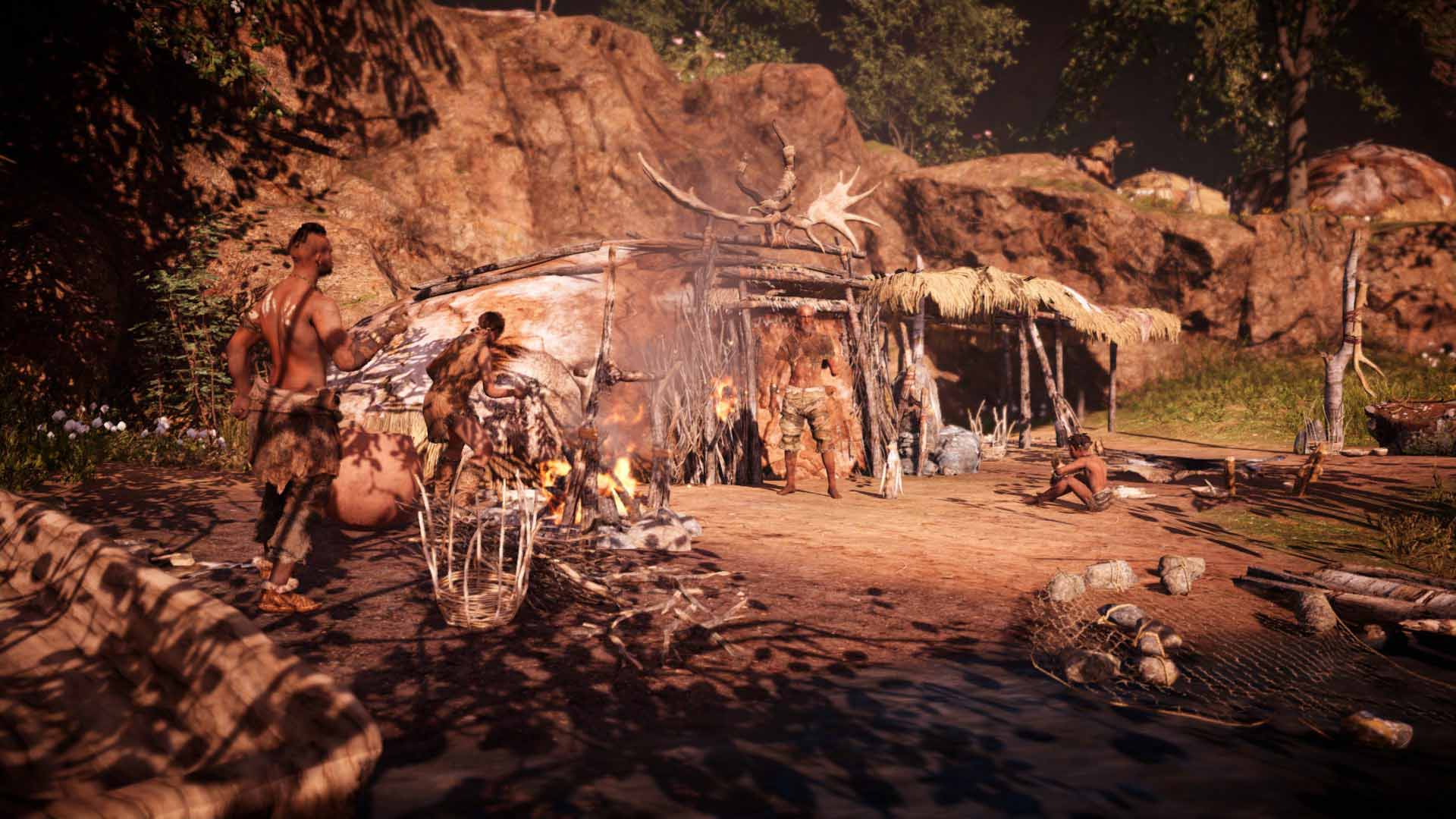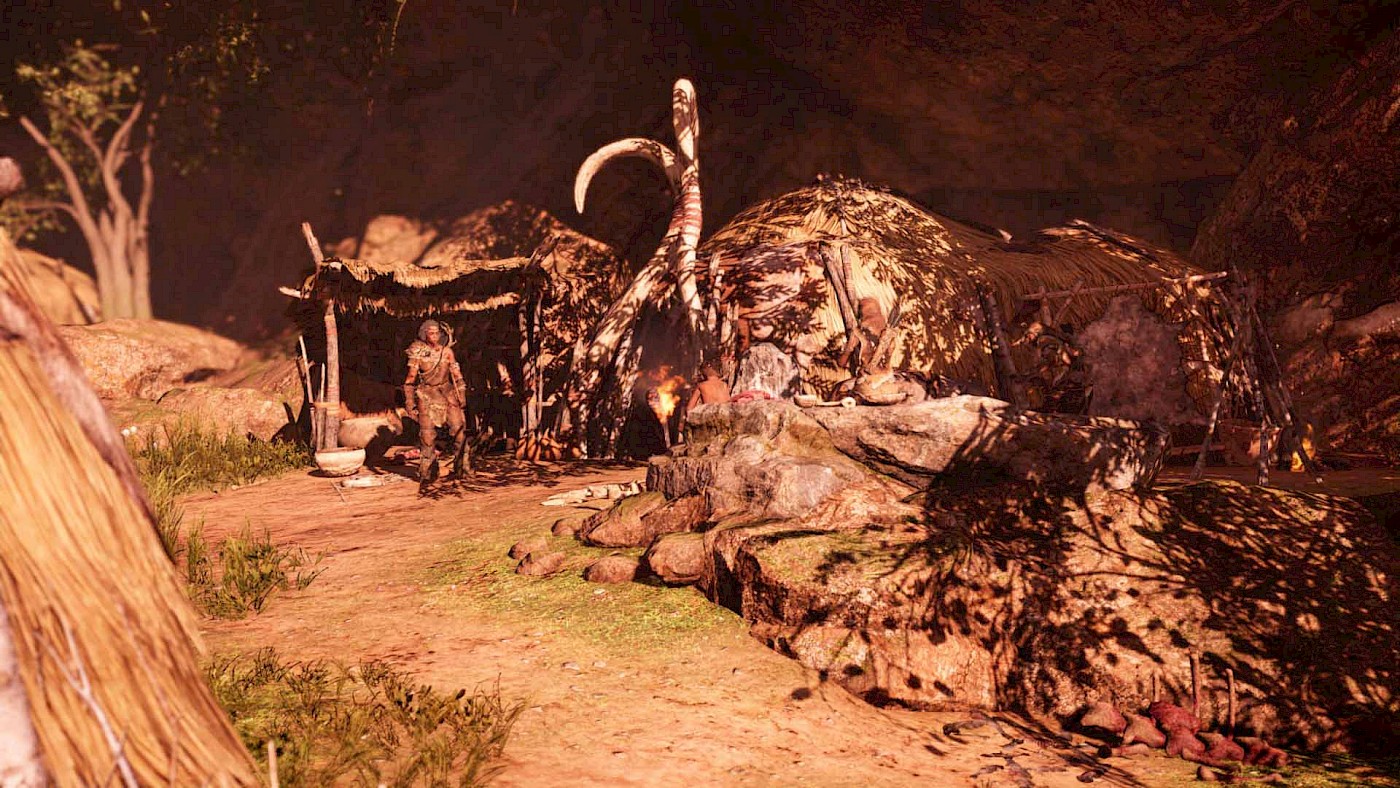Previously, we spent some time in Tutorial Land, rescued a young woman named Sayla, found a missing shaman by the name of Tensay, and finally went out to tame a wolf and rescue some wandering Wenja. Sayla gave us another task: to find more people with which to populate our village. There are a few people in particular that have been marked on my map. Time to find them and persuade them to join our little settlement.
There are a lot of beautiful things to see as you run across Oros. I spent an hour just going around and solving little missions. I tamed a few more animals, for example. One of those was a dhole. Like the Smilodon mentioned before, dholes didn’t exist in Europe. They are common throughout Asia, however. The game refers to them as wild dogs, which implies something that they’re not (i.e. dogs turned feral), but they are indeed closely related to the genus Canis. In any event, it’s another example of the developers throwing in a species of animal for what I assume is variety’s sake.
As is the case in many open world games, the geography is very compressed in Far Cry Primal. You can comfortably run from one end of the map within what I would guess is about a half hour’s worth of time. Most of the map seems to consist of temperate forest land, but it doesn’t take long to reach the northern regions, which are covered with snow and require me to wear heavier clothing (which I hadn’t yet unlocked) to avoid freezing to death. In the south, the climate is milder, with marshy areas. The two rival tribes are from either end of this geographic spectrum: the cannibalistic Udam are from the north, while the fire-worshipping Izila are from the south. I will write more about the different tribes in a future instalment in this series.

There are neat touches that the developers added to the valley of Oros, such as the stacked stones depicted above. (More elaborate ones are often referred to as cairns.) We don’t really know if Palaeolithic or Mesolithic people built such structures, but it doesn’t seem too far-fetched that people would have marked certain points in the landscape in a manner comparable to this. Archaeologically, the remains would be hard to identify, since the stones are unworked and the stacks would have collapsed and dispersed over time. But in some parts of the world, to this day, people occasionally stack stones to serve as markers. The Inuit use stacked stones to show that humans were there and you’re not in serious danger of getting lost. It seems reasonable to suppose that similar customs existed in the Palaeolithic and Mesolithic.
As I explore Oros, I help a small group of Wenja defend against Udam attackers. A little later, I rescue a Wenja prisoner from a number of Udam captors, making good use of the remarkably strong and quick black cave lion I tamed only a little later. Soon, I get a notification that I have enough materials to upgrade a hut or two back in the village. I return and find that Sayla has a mission for me. It turns out that some Udam are about to attack the village. Sure enough, they begin their assault almost immediately, and I come face to face with Ull, the leader of the Udam and one of my main enemies in the game. We’ll no doubt run into him again later.
The Udam are repelled with some difficulty. I’m sent out to take down an Udam camp. I do so by stealthily approaching the camp and setting fire to it from three sides, then killing the Udam that remain. Some Wenja also join me in the fight, and my cave lion again proves invaluable. Sayla is covered in blood and angry about the losses we sustained. I promise that soon I will take the fight to the Udam and destroy Ull with my own hands.

Back in the village, I see that our local shaman wants to talk to me. He again feeds me a skull filled with blood and adds two eyes removed from an Udam corpse, so I can “See through eyes of Udam.” This starts off the ‘Vision of Ice’. I see the Udam in a snowy landscape. They venerate a figurine modelled after the Venus of Willendorf (which actually predates the game’s setting by at least 15,000 years, though similar ones have been found that are as late as 11,000 years ago). I follow the figurine around, which grows to become gigantic, and have to defeat Udam as I go. ‘Why do we keep dying?’ I hear the Udam ask. Once I return to the real world, Tensay and I talk briefly. The Udam seemed ill, and what was the signifance of the figurine? The shaman says he will meditate on this. I leave the hut.
It’s time to find more of our people. I head off into the valley in search of specialists to join our village. They are conveniently highlighted on the map, and three of them seem to be within easy reach. I first set off to find Karoosh, a notable warrior who lost both his eye and his son to a guy named Mog. I save him from some Udam and burn a few of their corpses. He promises to meet me back at the village. I continue on and meet with Jayma the hunter. She accuses me of chasing off a bear and I promise to track it and bring it down. Using my cave lion, this proves to be easy and she promises to also meet me back at the village.
I decide to also head back to the village for a moment and see what’s new. I notice that there’s another skull with some kind of dark liquid outside of Tensay’s hut. The shaman pops up, says that it’s a strong drink, and wonders if I can handle it. I gulp it down, which starts the “Vision of Beasts”. I am now a mammoth and have to follow a ghost woolly rhino around. At different points, the ghost rhino stops and other rhinos spawn in that I have to defeat. The fight is a little frustrating, but I succeed and eventually destroy the ghost rhino itself. As an aside, both woolly mammoths (with some exceptions) and woolly rhinoceroses probably died out around the time that the game is set or a little later. Their extinction is regarded as part of the so-called Quarternary extinction event that saw the demise of a large number of species, most notably megafauna. The main problem with the game’s portrayal of these animals is that you find them roaming about in a wooded area, whereas in reality they would have preferred more open grasslands.

Finally, I go to meet with Wogah, who lost his arm to the Udam, who ate it. I get lured into a trap and fall down into a cave, at which point Wogah appears and pees on me, jokingly referring to me as “Piss Man” and claiming to be the last of the Wenja. I need to find a way out of this cave system, which is also inhabited by jaguars (which, you guessed it, never lived in Europe, but were, and still are, confined to the Americas). Eventually, I come across a primitive grappling hook. This is an unlikely piece of equipment to have existed back then, but I understand the game logic behind it. It allows me to climb up or down and thereby reach places that would otherwise be impossible to get to. Using the hook, I climb out and convince Wogah that he can trust me. He shows me a knife made from the ‘blood of Oros’ (obsidian, I guess), and challenges me to fetch more. I do so and he then joins the other Wenja at the village.
I’ve commented on this briefly in an earlier post, but considering that the village plays such a vital part in Far Cry Primal, it’s worth delving into this topic a little further. In the game, each major character that joins the Wenja settlement in Oros needs a hut for you to unlock new skills associated with that particular character. In order to build the hut, you need to gather materials, such as wood, animal skins, and so forth. Gathering these materials isn’t a chore; I managed to get enough for each character to build their huts immediately simply by harvesting resources whenever I happened to come across them and hunting the odd animal.
The Wenja village is already looking quite impressive. There are some walls (made from timbers), a few lookout posts, and a simple wooden bridge. The huts themselves look sturdy. The question, of course, is whether or not people in 10,000 BC really would have constructed a settlement like this. The game is set at the very end of the last Ice Age, around the time when the Upper Palaeolithic gave way to the Mesolithic in Europe. During that period, food could sometimes be so plentiful that, indeed, people could afford to stay in one spot for longer, and it would be natural for them to erect more impressive dwellings. The huts in game compare well with, for example, remains of a hut unearthed at Terra Amata (near Nice, France), which is about 400,000 years old. Certainly, the importance that the Wenja seem to attach to shells suggest that they prefer stable sources of food that allow them to reside longer in a particular place.

Some of the most impressive type of dwellings that date back to the Upper Palaeolithic are the huts made from mammoth bones and tusks, such as those found in Ukraine, Poland, and other parts of Eastern Europe that date back to 15,000 years ago (if not earlier). Indigenous peoples of the Pacific Northwest Coast in North America also subsisted on hunting, gathering, and fishing; they also built impressive villages and longhouses. Relatively recently, archaeologists also discovered a fairly large site with monumental stone architecture at Göbekli Tepe in Turkey that was used in the tenth to eighth millennium BC by hunter-gatherers (the Wikipedia article offers a decent overview).
Of course, we know that people in the Stone Age also dwelled in caves, and the game plays around with this idea, too. The village is, after all, built just outside of the entrance of a cave, and Takkar’s dwelling is actually located a little inside it. There are also caves and overhangs elsewhere in Oros that serve as shelters. And so the bottom line is that while nothing like the village shown in Far Cry Primal has, to my knowledge, ever been found, it certainly isn’t outside of the realm of possibility that something like that might have actually existed in ca. 10,000 BC, especially in a region as rich as the valley of Oros is said to be.
With the village improved and more specialists added to the population, it’s time to continue playing through the rest of the story. There are many, many icons on the map, highlighting places worth visiting, side missions to complete, further people to rescue, and so on. But Sayla has also just given me a mission. A Wenja hunter went to the so-called Bone Cave to look for food and hasn’t returned yet. It’s up to me to follow in his footsteps and see what became of him. I’ll investigate next time.
